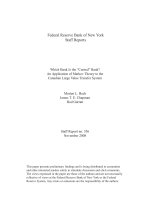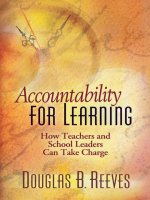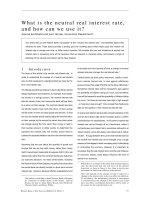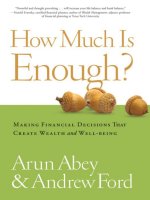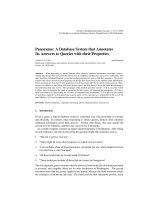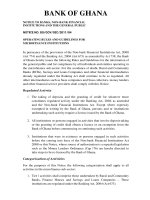How Much Is Enough? Making Financial Decisions That Create Wealth and Well-being
Bạn đang xem bản rút gọn của tài liệu. Xem và tải ngay bản đầy đủ của tài liệu tại đây (1.69 MB, 556 trang )
What people said about the first edition
of
How Much Is Enough?
“The best book I have ever read on money, happiness, and the
steps you can take to achieve your dreams. With simple
explanations, easy-to-follow suggestions, and a gentle grace,
the authors guide you along the path to greater self-
understanding and enhanced well-being. It is an outstanding
book. Read it and you will live a happier life.”
—Dr. Richard L. Peterson, founder, Market Psychology
Consulting, and author of Inside the Investor’s Brain: The
Power of Mind over Money
“Simply put, this is a GREAT book to read, but you’ll nd it’s
even a BETTER book to use. As I read it, I found myself
wishing I had written it myself.”
—Doug Lennick, CFP, CEO, Lennick Aberman Group, and
coauthor of Moral Intelligence: Enhancing Business
Performance and Leadership Success
“The authors open a whole new world that ties the psyche to
the state of our nances. How Much Is Enough? is more than
any guidebook found on the shelves of the self-help section.
Its outstanding quality is the depth at which it explores the
tie between mental choices and the decisions that govern our
nancial status … the ideas that have been introduced
challenge the way we see money and proer a guide to
maximize our wealth potential.”
—MillionaireAsia, January 2008
“Fascinating and challenging. I’ve read it from cover to cover
and can’t stop thinking about it. I’ve determined to buy it for
each of my children.”
—Dr. Rosemary Howell, chairman, Strategic Action Pty. Ltd.
“Threatens to have long-lasting and far-reaching consequences
for financial planning.”
—Sydney Morning Herald, November 17, 2007
“Wonderful insights into the role of money, happiness, and
how to lead a meaningful life.”
—Raymond Ackerman, founder, Pick ’n Pay, and author of
Hearing Grasshoppers Jump
“Conveys a central message. Work from the inside out.
Financial success is only one part of a multifaceted person.
Knowing what is important to you is the rst thing you need
to know; getting the resources to achieve that ultimate goal is
just a supporting role. There is the need for the earnest
pursuit of a different type of capital. Happiness Capital.”
—Wealth, September 2007
“Thought-provoking and ultimately uplifting—I will be
permanently better off for having read it.”
—James O’Loughlin, author of The Real Warren Buffett
“Abey and Ford delve into the reasons why even though we’re
living longer, are richer and have more choices than ever
before, many of us fail to choose things in life that make us
truly happy. This practical guide uses interesting real life
case studies to illustrate its teachings … not only will this
book inspire you, it will guide you through practical
strategies to enable you to live your dream.”
—The Finder, September 2007
Austin, TX
www.greenleafbookgroup.com
First edition published 2007 by A&B Publishers Pty. Ltd. atf
A&B Trust, Australia
Copyright ©2009 by Arun Abey and Andrew Ford
All rights reserved under all copyright conventions.
No part of this book may be reproduced, stored in a retrieval
system, or transmitted by any means, electronic, mechanical,
photocopying, recording, or otherwise, without written
permission from the publisher.
Distributed by Greenleaf Book Group LLC
For ordering information or special discounts for bulk
purchases, please contact Greenleaf Book Group LLC at PO
Box 97869, Austin, TX 78709, (512) 891-6100.
Design and composition by Greenleaf Book Group LLC
Cover design by Greenleaf Book Group LLC
Publisher’s Cataloging-In-Publication Data
(Prepared by The Donohue Group, Inc.)
Abey, Arun.
How much is enough? : making financial decisions that
create wealth and well-being / Arun Abey & Andrew Ford.
2nd ed.
p. : charts ; cm.
Previous ed. published: [Sydney], Australia : A&B
Publishers Pty Ltd atf A&B Trust, 2007.
Includes bibliographical references and index.
eISBN: 978-1-60832-149-0
1. Finance, Personal. 2. Investments. I. Ford, Andrew (Andrew
Robert James), 1968- II. Title.
HG179 .A249 2009
332.024/01 2008944175
Part of the Tree Neutral™ program, which
offsets the number of trees consumed in
the production and printing of this book
by taking proactive steps, such as planting
trees in direct proportion to the number of
trees used: www.treeneutral.com
Printed in the United States of America on acid-free paper
09 10 11 12 13 14 10 9 8 7 6 5 4 3 2
Second Edition
Authors’ note: This book provides general
information about money, investment, and
people’s attitudes toward these subjects.
Every eort has been made to ensure that
the contents of the book are accurate at the
time of publication. Investment markets and
the factors that drive them are constantly
changing, however. Information in the book
is in no way intended to replace or
supersede independent or other professional
advice. Neither the authors nor the publisher
may be held responsible for any action or
claim resulting from the use of this book or
any information contained in it. References
to dollars, unless otherwise specied, are to
U.S. dollars.
The various case studies and stories of
people’s lives are drawn from real-life
experiences that in some cases involve
composite stories. People’s names have been
changed in these stories to protect their
privacy.
To our clients around the world,
who have given us their trust and
the privilege of sharing in their life dreams
CONTENTS
Acknowledgments
Foreword
Introduction Richer and Happier
PART 1 The Bridge of Well-being
Chapter 1 The Foundations
Chapter 2 The Meaning of Money
Chapter 3 The Happiness Challenge
Chapter 4 Strategies for Well-being
Chapter 5 Kids, Money, and Happiness
Chapter 6 Giving with Meaning
Further Reading for Part 1
PART 2 Wealth Habits
Chapter 7 The Investment Prize
Chapter 8 The Madness of Myopia
Chapter 9 How to Be Prudent and Take
the Long View
Chapter 10 The Puzzling Properties of
Property
Chapter 11 Confronting the Enemy Within
Further Reading for Part 2
PART 3 Wealth and Well-being
Chapter 12 Good and Bad Advisers
Chapter 13 How Much Is Enough?
References
Index
About the Authors
ACKNOWLEDGMENTS
SINCE THE PUBLICATION OF THE FIRST EDITION of How
Much Is Enough? we have spent countless
hours discussing, further researching, and
making presentations to a range of
audiences on the themes of money and well-
being raised in the book. We have been
pleased by the strong level of reader
engagement we have received and the
personal stories that have been shared
openly. It seems we are not the only ones
asking, and attempting to answer, the
question “How much is enough?”
While many of these letters and
conversations have been private, one of the
most memorable was from an executive who
had that morning taken a break from his
hectic schedule to walk his young daughter
to school for the rst time in months. He
had then taken the trouble to e-mail us to
explain how much this simple act had meant
to him—and to his daughter. We would like
to thank each of these correspondents and,
where possible, we have incorporated their
insights into the text of this revised and fully
updated edition.
This edition also features an additional
chapter titled “Kids, Money, and
Happiness.” Parents of young children in
particular have asked for more information
on the fascinating challenge of inculcating
in our children a healthy respect for the
important role that money can play in life,
combined with an appreciation of the
importance of personal values and goals to
well-being. In short, most readers seem to
want their kids to understand that while
money matters a great deal, at the end of
the day it is an “enabler.” Provided you
have sucient money to cover the basic
necessities in life, there are in fact more
important things to aim for.
Many people have helped to make this
book what it is. Shlomo Benartzi spent
considerable time reviewing content and
providing useful suggestions to make it
more accessible. Ross Ackland, Brett Nan
Tie, James Murray, Melanie Nutbeam, Chloe
Yildiz, and Patrick Au-Yeung provided
essential research assistance. Bernie Bolger
shared valuable insights and personal
experience, as well as assisted with the
research.
The following individuals also provided
valuable comments: Shaun Bonnét, Andrew
Bradley, Jon Brett, Walter Carpenter, Paul
Clitheroe, John Dani, Harold Evensky,
Tanya Ford, Susan Foster, Letetia Gibbs,
Tony Gilding, Tony Green, Peeyush Gupta,
Jenny Hill-Ling, Peter Janssen, Helen Jones,
Antony Kidman, Anthony Kongats, Helen
Lynch, Alan McCormack, Andrew Penn,
Mark Peterie, Geo Roberts, Cli
Rosenberg, Tim Sharp, Du Watkins, and
Heidl Wolter.
Vicki Jackson and Shabnum Stevens
assisted with typing, graphics, and logistics.
Linda O’Doughda was a vigilant and
eective editor, and Bill Crawford also
provided important input.
ipac securities provided considerable
production support, and so many colleagues
at ipac and AXA provided help and
encouragement that it would be impossible
to name them all. Their help was
nonetheless greatly appreciated. Any errors
or omissions are of course our responsibility.
Last, but most important, our families
provided the love, encouragement, and
practical support that enabled us to keep
the faith despite the long period of time
taken to complete the book.
—Arun Abey and Andrew Ford
Spring 2009
FOREWORD
IF YOU SERIOUSLY CONSIDER THE QUESTION, reecting
on the title alone—How Much Is Enough?
—would justify owning this book. As Arun
and Andrew so pointedly note in the rst
few pages, as a society we have become far
richer in the past fifty years but we have not
become happier! Obviously, we need to step
back and consider this sad reality. The
authors have a passion, and that passion is
to ensure that when we look back ten and
twenty years from now, we will be happier.
This book provides the ideas, suggestions,
tips, and strategies for assisting us in
moving both practically and emotionally
onto the right path to win the Happiness
Prize.
In her books, my partner, Deena Katz,
tells the story of her mom (and others of her
generation) who bought a refrigerator when
she needed one. Today we buy one when we
want one. No money, no problem; just get a
loan. How depressing. No wonder we’re not
happier. How did we get here? How Much Is
Enough? alerts us to the fact that consumer
marketing is increasingly focused on
ensuring that we are dissatised with what
we have and who we are. It then proceeds
to introduce the concept of hedonistic
opportunity cost, that is, a measure of
happiness foregone. This is a powerful tool
that reframes our focus from price to utility.
The simple example provided by the
authors, “think of the cost of a much more
expensive car in terms of, say, the
additional happiness that a family holiday
overseas … may have produced,” is just one
example of the multitude of tidbits that we
can immediately incorporate into our daily
lives.
Although it’s impossible to highlight one
part of the book as most important,
following their powerful introductory
sections on foundations and “the meaning
of money,” the authors address one issue of
supreme interest to many of us: kids,
money, and happiness. Noting that research
has consistently shown that money habits
are generally inculcated before a child’s
tenth birthday, this section jump-starts our
eorts to set our children on the path to
happiness. In fact, one of my favorite ideas
is the Family Bank, but you’ll have to read
the book to see why.
Another discussion, perhaps obvious in
hindsight but one we all too often forget, is
the reminder that the “Ultimate Prize is to
move from a life that is successful for you,
to a life that is also meaningful to others.” If
the book simply reminded us of this reality,
it would be useful; however, as with each
chapter, it goes far beyond a wake-up call;
it provides ideas and strategies that enable
us to creatively implement giving with
meaning. In fact, I’ve already changed my
holiday gifting plans based on what I
learned.
As one would expect of a book coauthored
by a leading strategic thinker and the
founder of ipac, one of the world’s largest
nancial planning companies, investments
play a big role in the story of How Much Is
Enough? However, unlike all too many
investment guides, this book is well founded
in both solid investment theory and real-
world practicality. Recognizing that the
critical “dierence between success and
failure is not how investment markets
behave … but how investors behave,” the
authors introduce the reader to the lessons
of behavioral nance. You’ll learn about the
dangers of loss aversion and investment
regret and the concepts of time horizons and
risk premium. What you learn will increase
your likelihood of winning the Investment
Prize. Even then, as a practitioner, I’m
obviously biased, and I believe that
investors are well served by good
professional advice. So, I was pleased to
nd a very solid chapter on evaluating and
selecting good advisers.
I could go on and on, but I would still not
do credit to this most important volume.
With the overriding theme that we need to
focus on our life, not our money in order to
win the Happiness Prize, How Much Is
Enough? delivers on its promise to assist
you, the reader, “to improve not just your
bank balance but your life balance.”
—Harold Evensky, CFP, President, Evensky
& Katz
Author of Wealth Management and coeditor
of The Investment Think Tank and Retirement
Income Redesigned, Adjunct Professor, Texas
Tech University
INTRODUCTION:
RICHER AND HAPPIER
EACH ONE OF US WANTS TO BE HAPPY AND HAVE ENOUGH
MONEY, and the good news is that today’s
world oers the opportunity for both. By
planning, taking some simple, practical
steps, and—above all—becoming master of
your mind, you can have it all.
Thanks to advances in technology,
medicine, and other elds during the past
hundred years, we’re living longer,
healthier, and wealthier lives. We have
more choices too. In fact, most people now
have an unprecedented array of options in
everything from education and career to
housing, medical treatment, and retirement.
Fortunately, we also have the nancial
potential to exploit the choices available to
us.


